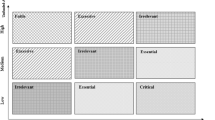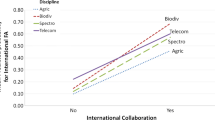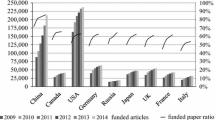Abstract
Research funding plays a key role in current science, thus it has become an aggregative interesting level in scientometric analysis. In this work, we try to explore the funding ratios of 21 major countries/territories in social science based on 813,809 research articles collected from the Web of Science and indexed by the Social Sciences Citation Index covering the period from 2009 to 2013. The results show that the funding ratios of sample countries/territories in social science are far below that in natural science and some specific subjects (chemistry, engineering, physics, neurosciences). However, there is a positive correlation between them. The funding ratios of People’s Republic of China, Sweden and Japan rank the top 3 (over 30 %). Generally, the funding ratios of the top 1 % and top 10 % highly cited articles are higher than those of the rest of articles, and for most cases, the high funding ratio of all articles is related to the high funding ratio of the highly cited articles.



Similar content being viewed by others
References
Costas, R., & van Leeuwen, T. N. (2012). Approaching the “reward triangle”: General analysis of the presence of funding acknowledgments and “peer interactive communication” in scientific publications. Journal of the American Society for Information Science and Technology, 63(8), 1647–1661.
Cyranoski, D. (2014). Fundamental overhaul of China’s competitive funding. Nature News Blog, http://blogs.nature.com/news/2014/10/fundamental-overhaul-of-chinas-competitive-funding.html.
Diaz-Faes, A. A., & Bordons, M. (2014). Acknowledgments in scientific publications: Presence in Spanish science and text patterns across disciplines. Journal of the Association for Information Science And Technology, 65(9), 1834–1849.
Jowkar, A., Didegah, F., & Gazni, A. (2011). The effect of funding on academic research impact: A case study of Iranian publications. Aslib Proceedings, 63(6), 593–602.
Lane, J. (2009). Assessing the impact of science funding. Science, 324(5932), 1273–1275.
Li, J., & Li, Y. T. (2015). Patterns and evolution of coauthorship in China’s humanities and social sciences. Scientometrics, 102(3), 1997–2010.
Liu, Q., & Ding, R. C. (2014). Impacts of SSCI on the academic research of Chinese scholars: Taking education discipline as an example. Comparative Education Review, 7, 87–92. (in Chinese).
Pislyakov, V., & Shukshina, E. (2014). Measuring excellence in Russia: Highly cited papers, leading institutions, patterns of national and international collaboration. Journal of the Association for Information Science and Technology, 65(11), 2321–2330.
Shapira, P., & Wang, J. (2010). Follow the money. Nature, 468(7324), 627–628.
Tan, A. M., Zhao, S. X., & Ye, F. Y. (2012a). Funds promote scientific output. Current Science, 102(4), 542–543.
Tan, A. M., Zhao, S. X., & Ye, F. Y. (2012b). Characterizing the funded scientific collaboration network. Current Science, 103(11), 1261–1262.
Tijssen, R. J. W., Visser, M. S., & van Leeuwen, T. N. (2002). Benchmarking international scientific excellence: Are highly cited research papers an appropriate frame of reference? Scientometrics, 54(3), 381–397.
Wang, X. W., Liu, D., Ding, K., & Wang, X. R. (2012). Science funding and research output: A study on 10 countries. Scientometrics, 91(2), 591–599.
Wang, J., & Shapira, P. (2011). Funding acknowledgement analysis: An enhanced tool to investigate research sponsorship impacts: The case of nanotechnology. Scientometrics, 87(3), 563–586.
Zhao, X., Gao, X. Q., & He, P. (2009). The h-index of science funding: Comprehensively measuring the quantity and impact of funded articles. Bulletin of National Natural Science Foundation of China, 2009(1), 15–18.
Zhao, S. X., & Ye, F. Y. (2011). h-Efficiency: Measuring input–output performance of research funds. Current Science, 101(1), 21–22.
Zhou, P., & Tian, H. B. (2014). Funded collaboration research in mathematics in China. Scientometrics, 99(3), 695–715.
Acknowledgments
This work was improved by thoughtful comments of two anonymous reviewers and was supported by National Social Science Foundation of China (No. 12CTQ049). The authors acknowledge Dr. Lin Lili and Mr. Alejandro Alda for helping us to revise the manuscript.
Author information
Authors and Affiliations
Corresponding author
Rights and permissions
About this article
Cite this article
Xu, X., Tan, A.M. & Zhao, S.X. Funding ratios in social science: the perspective of countries/territories level and comparison with natural sciences. Scientometrics 104, 673–684 (2015). https://doi.org/10.1007/s11192-015-1633-3
Received:
Published:
Issue Date:
DOI: https://doi.org/10.1007/s11192-015-1633-3




